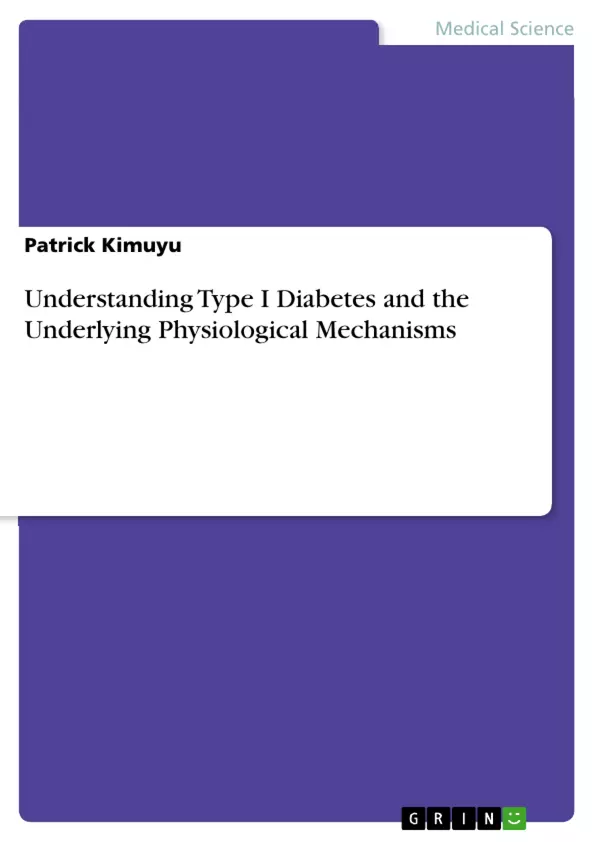Diabetes entails a collection of metabolic disorders which are usually characterized by prolonged high sugar levels in an individual’s blood. For instance, both type 1 diabetes (T1D) and type 2 diabetes (T2D) are characterized with hyperglycemia. This condition is referred as hyperglycemia, and it has been found to cause debilitating health consequences. Van Belle, Coppieters and von Herrath (2011) report reaffirm that chronic hyperglycemic conditions may lead to health complications including heart disease, blindness, kidney failure, stroke, and ketoacidosis. Ordinarily, T2D occurs due to insulin resistance in which adipose or muscle cells exhibit low response to insulin. This phenomenon is associated to old age or obesity. In contrast, T1D is caused by autoimmune destruction of pancreatic beta-cells which are responsible for the production of insulin (Ozougwu, Obimba, Belonwu & Unakalamba, 2013). Currently, diabetes presents an immense challenge to the global public health system (Kimuyu, 2018). Therefore, this discussion focuses on the key aspects of type 1 diabetes.
Inhaltsverzeichnis (Table of Contents)
- Introduction
- Epidemiology
- Impact of T1D on Life.
- Disease Process.
- Signs of T1D....
- Etiology of T1D
- Genetics of T1D
- Cause of Beta Cells Destruction.
- Environmental Triggers
- Nutritional Triggers of T1D.
- Protective Dietary Components....
- Pathophysiology of T1D
- Effect of T1D on Body Systems
- Conclusion........
Zielsetzung und Themenschwerpunkte (Objectives and Key Themes)
This discussion provides a comprehensive overview of type 1 diabetes (T1D), focusing on its epidemiology, impact on life, disease process, etiology, and pathophysiology.
- The epidemiology of T1D, including its prevalence and demographic disparities.
- The impact of T1D on various aspects of life, such as life expectancy, social life, and psychosocial well-being.
- The underlying mechanisms of T1D, particularly the autoimmune destruction of pancreatic beta cells.
- The genetic and environmental factors involved in the etiology of T1D, including specific genes implicated in the disease.
- The pathophysiology of T1D, including its effects on different body systems.
Zusammenfassung der Kapitel (Chapter Summaries)
The introductory chapter defines diabetes as a collection of metabolic disorders characterized by prolonged high blood sugar levels. The discussion specifically focuses on type 1 diabetes (T1D), highlighting its causes and the impact of chronic hyperglycemia on various health conditions.
The chapter on Epidemiology explores the prevalence of T1D, particularly its higher occurrence among children compared to adults in the United States. It also highlights demographic disparities, with non-Hispanic whites being more affected than other ethnic populations.
The chapter on Impact of T1D on Life examines the adverse effects of T1D on various aspects of life, including lowered life expectancy, social interactions, and psychosocial well-being. It emphasizes the heightened risk of psychosocial factors among adolescents with T1D.
The chapter on Disease Process delves into the progressive destruction of beta cells in T1D. This destruction is attributed to the immune system's targeting of insulin-producing Islets of Langerhans, leading to decreased insulin production and hyperglycemia.
The chapter on Signs of T1D explores the typical signs and symptoms of T1D, including polyphagia, polyuria, ketonemia, and polydipsia. While these signs are more acute in children, adults can experience similar symptoms, although less pronounced.
The chapter on Etiology of T1D investigates the various factors that contribute to the development of T1D. It discusses the role of genetic factors, highlighting specific genes involved in the disease process, and explores the impact of environmental triggers.
Schlüsselwörter (Keywords)
Key terms and concepts explored in this discussion include type 1 diabetes (T1D), hyperglycemia, beta-cell destruction, autoimmune response, genetics, HLA gene, insulin gene, environmental triggers, pathophysiology, and impact on life.
- Quote paper
- Patrick Kimuyu (Author), 2018, Understanding Type I Diabetes and the Underlying Physiological Mechanisms, Munich, GRIN Verlag, https://www.hausarbeiten.de/document/411946


